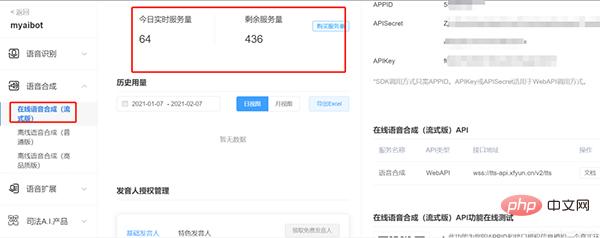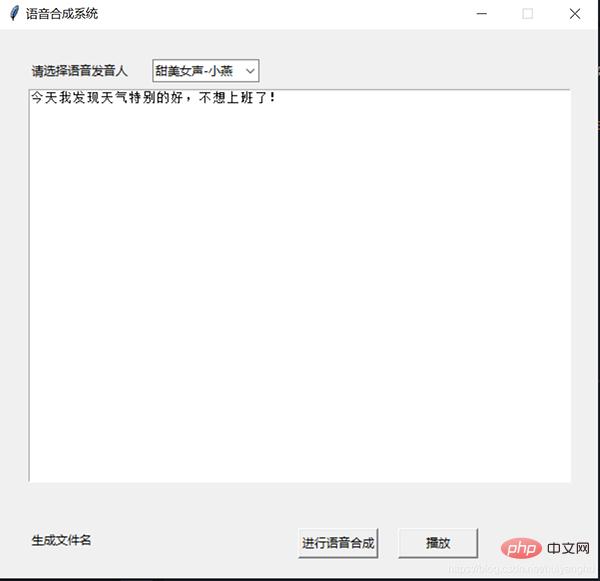Home > Article > Backend Development > Use Python to build a speech synthesis system

Hello everyone, I am Python artificial intelligence technology
I have always been interested in speech synthesis systems. I always want to be able to synthesize some content for myself, such as synthesizing novels, broadcasting the e-books I downloaded to me, etc.

is actually a tool based on speech synthesis, but this thing is very difficult to develop because many manufacturers provide it in the form of API. Reduced, you only need to call a few APIs to implement your own speech synthesis tool; although the sparrow is small, it has all the internal organs. On a larger scale, this is a small speech synthesis system.
First we need to install
Here we choose the WebAPI interface of the iFlytek open platform.
https://www.xfyun.cn/doc/tts/online_tts/API.html
First we go to the console to create an application

After creating it, click on the application to enter, and there will be a detailed column for the application.
Click on the speech synthesis on the left, and then go to the next level of online speech synthesis (streaming version)

On the upper right side, we need to get 3 Something:
Okay, let’s proceed to the code Implemented, first install the two libraries we need.
pip install websocket-client pip install playsound
Next we define a class play, including 4 functions
class play: def __init__(self): #初始化函数 def play_sound(self):#播放音频函数 def select_vcn(self,*arg):#选择下拉框设置发音人 def xfyun_tts(self):#进行语音合成
Here, you need to fill in the appid, appkey and appsecret you just obtained from the iFlytek open platform console
def __init__(self):
self.APP_ID = 'xxx' #请填上自己的appid
self.API_KEY = 'xxx'#请填上自己的appkey
self.SECRET_KEY = 'xxx' #请填上自己的appsecret
self.root=tk.Tk() #初始化窗口
self.root.title("语音合成系统") #窗口名称
self.root.geometry("600x550") #设置窗口大小
self.root.resizable(0,0)
#self.root.resizable(width=True,height=True)#设置窗口是否可变,宽不可变,高可变,默认为True
self.lb=tk.Label(self.root,text='请选择语音发音人')#标签
self.tt=tk.Text(self.root,width=77,height=30) #多行文本框
self.cb=ttk.Combobox(self.root, width=12)#下拉列表框
#设置下拉列表框的内容
self.cb['values']=("甜美女声-小燕","亲切男声-许久","知性女声-小萍", "可爱童声-许小宝","亲切女声-小婧")
self.cb.current(0)#将当前选择状态置为0,也就是第一项
self.cb.bind("<>", self.select_vcn)
self.tk_tts_file=tk.Label(self.root,text='生成文件名')
self.b1=tk.Button(self.root, text='进行语音合成', width=10,height=1,command=self.xfyun_tts) #按钮
self.tk_play=tk.Button(self.root, text='播放', width=10,height=1,command=self.play_sound) #按钮
#各个组件的位置
self.tk_tts_file.place(x=30,y=500)
self.b1.place(x=300,y=500)
self.tk_play.place(x=400,y=500)
self.lb.place(x=30,y=30)
self.cb.place(x=154,y=30)
self.tt.place(x=30,y=60)
self.root.mainloop() When the drop-down list is selected, set the corresponding pronunciator
def select_vcn(self,*arg): if self.cb.get()=='甜美女声-小燕': self.vcn="xiaoyan" elif self.cb.get()=='亲切男声-许久': self.vcn="aisjiuxu" elif self.cb.get()=='知性女声-小萍': self.vcn="aisxping" elif self.cb.get()=='可爱童声-许小宝': self.vcn="aisbabyxu" elif self.cb.get()=='亲切女声-小婧': self.vcn="aisjinger" print(self.vcn)
Next we will modify the Python demo that comes with iFlytek to make it more convenient to use. In addition, search the public account programmer Xiaole's backend and reply "make money" to get a surprise gift package.
# -*- coding:utf-8 -*-
#
# author: iflytek
#
#本demo测试时运行的环境为:Windows + Python3.7
#本demo测试成功运行时所安装的第三方库及其版本如下:
# cffi==1.12.3
# gevent==1.4.0
# greenlet==0.4.15
# pycparser==2.19
# six==1.12.0
# websocket==0.2.1
# websocket-client==0.56.0
# 合成小语种需要传输小语种文本、使用小语种发音人vcn、tte=unicode以及修改文本编码方式
#错误码链接:https://www.xfyun.cn/document/error-code (code返回错误码时必看)
# # # # # # # # # # # # # # # # # # # # # # # # # # # # # # # # # # # # # # # # # # # # # # # # # # # # # # # # # # # #
import websocket
import datetime
import hashlib
import base64
import hmac
import json
from urllib.parse import urlencode
import time
import ssl
from wsgiref.handlers import format_date_time
from datetime import datetime
from time import mktime
import _thread as thread
import os
import wave
STATUS_FIRST_FRAME = 0# 第一帧的标识
STATUS_CONTINUE_FRAME = 1# 中间帧标识
STATUS_LAST_FRAME = 2# 最后一帧的标识
PCM_PATH = "./demo.pcm"
class Ws_Param(object):
# 初始化
def __init__(self):
pass
def set_tts_params(self, text, vcn):
if text != "":
self.Text = text
if vcn != "":
self.vcn = vcn
# 业务参数(business),更多个性化参数可在官网查看
self.BusinessArgs = {"bgs":1,"aue": "raw", "auf": "audio/L16;rate=16000", "vcn": self.vcn, "tte": "utf8"}
#使用小语种须使用以下方式,此处的unicode指的是 utf16小端的编码方式,即"UTF-16LE"”
#self.Data = {"status": 2, "text": str(base64.b64encode(self.Text.encode('utf-16')), "UTF8")}
self.Data = {"status": 2, "text": str(base64.b64encode(self.Text.encode('utf-8')), "UTF8")}
def set_params(self, appid, apiSecret, apiKey):
if appid != "":
self.APPID = appid
# 公共参数(common)
self.CommonArgs = {"app_id": self.APPID}
if apiKey != "":
self.APIKey = apiKey
if apiSecret != "":
self.APISecret = apiSecret
# 生成url
def create_url(self):
url = 'wss://tts-api.xfyun.cn/v2/tts'
# 生成RFC1123格式的时间戳
now = datetime.now()
date = format_date_time(mktime(now.timetuple()))
# 拼接字符串
signature_origin = "host: " + "ws-api.xfyun.cn" + "n"
signature_origin += "date: " + date + "n"
signature_origin += "GET " + "/v2/tts " + "HTTP/1.1"
# 进行hmac-sha256进行加密
signature_sha = hmac.new(self.APISecret.encode('utf-8'), signature_origin.encode('utf-8'),
digestmod=hashlib.sha256).digest()
signature_sha = base64.b64encode(signature_sha).decode(encoding='utf-8')
authorization_origin = "api_key="%s", algorithm="%s", headers="%s", signature="%s"" % (
self.APIKey, "hmac-sha256", "host date request-line", signature_sha)
authorization = base64.b64encode(authorization_origin.encode('utf-8')).decode(encoding='utf-8')
# 将请求的鉴权参数组合为字典
v = {
"authorization": authorization,
"date": date,
"host": "ws-api.xfyun.cn"
}
url = url + '?' + urlencode(v)
return url
def on_message(ws, message):
try:
#print(message)
try:
message =json.loads(message)
except Exception as e:
print("111",e)
code = message["code"]
sid = message["sid"]
audio = message["data"]["audio"]
audio = base64.b64decode(audio)
status = message["data"]["status"]
print(code, sid, status)
if status == 2:
print("ws is closed")
ws.close()
if code != 0:
errMsg = message["message"]
print("sid:%s call error:%s code is:%s" % (sid, errMsg, code))
else:
with open(PCM_PATH, 'ab') as f:
f.write(audio)
except Exception as e:
print("receive msg,but parse exception:", e)
# 收到websocket错误的处理
def on_error(ws, error):
print("### error:", error)
# 收到websocket关闭的处理
def on_close(ws):
print("### closed ###")
# 收到websocket连接建立的处理
def on_open(ws):
def run(*args):
d = {"common": wsParam.CommonArgs,
"business": wsParam.BusinessArgs,
"data": wsParam.Data,
}
d = json.dumps(d)
print("------>开始发送文本数据")
ws.send(d)
if os.path.exists(PCM_PATH):
os.remove(PCM_PATH)
thread.start_new_thread(run, ())
def text2pcm(appid, apiSecret, apiKey, text, vcn, fname):
wsParam.set_params(appid, apiSecret, apiKey)
wsParam.set_tts_params(text, vcn)
websocket.enableTrace(False)
wsUrl = wsParam.create_url()
ws = websocket.WebSocketApp(wsUrl, on_message=on_message, on_error=on_error, on_close=on_close)
ws.on_open = on_open
ws.run_forever(sslopt={"cert_reqs": ssl.CERT_NONE})
pcm2wav(PCM_PATH, fname)
def pcm2wav(fname, dstname):
with open(fname, 'rb') as pcmfile:
pcmdata = pcmfile.read()
print(len(pcmdata))
with wave.open(dstname, "wb") as wavfile:
wavfile.setparams((1, 2, 16000, 0, 'NONE', 'NONE'))
wavfile.writeframes(pcmdata)
wsParam = Ws_Param()The final speech synthesis system was implemented in this way.

Currently, various cloud computing and cloud services are developing rapidly, and major companies have provided abundant resources, which has greatly lowered the threshold for artificial intelligence development and does not require knowledge of speech synthesis. Based on the principle, a speech synthesis tool can be quickly developed!
The above is the detailed content of Use Python to build a speech synthesis system. For more information, please follow other related articles on the PHP Chinese website!